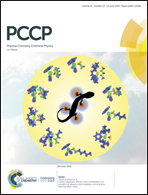Atomistic insights into cesium chloride solution transport through the ultra-confined calcium–silicate–hydrate channel
Abstract
The transport of water and ions in the gel pores of calcium silicate hydrate (C–S–H) determines the durability of cement material. In this study, molecular dynamics was employed to investigate the capillary imbibition process of CsCl solution in the C–S–H channel. The advanced frontier of CsCl solution flow inside the C–S–H capillary shows a concave meniscus shape, which reflects the hydrophilic properties of the C–S–H substrate. Reynolds number calculations show that the transport process is laminar flow and dominated by viscous forces. The invading depth of the CsCl solution deviates from the theoretical prediction of the classic Lucas–Washburn (L–W) equation, but the modified theoretical equation, by incorporating the effect of slip length, dynamic contact angle, and effective viscosity into the L–W equation, can describe the penetration curve of the solution very well. The validity of our developed theoretical equation was confirmed by additional systems with different ion concentrations. In addition, the local structure of ions was analyzed to elucidate the effect of ion concentration on the transport process. The adsorption and accumulation of ions retard the transport process of water. With an increase in the ionic concentration, the effects of immobilization and cluster accumulation became more pronounced, further reducing the transport rate of water. This study provides fundamental insight into the transport behavior of liquid in the gel pores of cement-based material.



 Please wait while we load your content...
Please wait while we load your content...